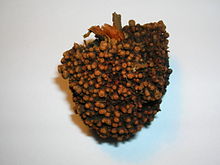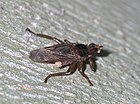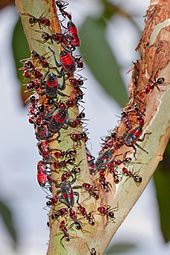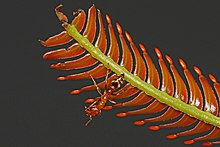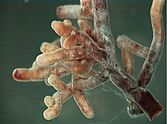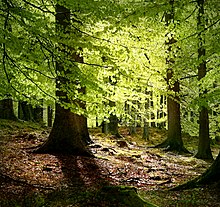In a cleaning symbiosis, the clownfish feeds on small invertebrates that otherwise have potential to harm the sea anemone,
and the fecal matter from the clownfish provides nutrients to the sea
anemone. The clownfish is protected from predators by the anemone's
stinging cells, to which the clownfish is immune. The clownfish emits a
high pitched sound that deters butterfly fish, which would otherwise eat
the anemone, making the relationship appear mutualistic.
Symbiosis (from Greek συμβίωσις "living together", from σύν "together" and βίωσις "living") is any type of a close and long-term biological interaction between two different biological organisms, be it mutualistic, commensalistic, or parasitic. The organisms, each termed a symbiont, may be of the same or of different species. In 1879, Heinrich Anton de Bary
defined it as "the living together of unlike organisms". The term was
subject to a century-long debate about whether it should specifically
denote mutualism, as in lichens; biologists have now abandoned that restriction.
Symbiosis can be obligatory, which means that one or both of the
symbionts entirely depend on each other for survival, or facultative
(optional) when they can generally live independently.
Symbiosis is also classified by physical attachment; symbiosis in
which the organisms have bodily union is called conjunctive symbiosis,
and symbiosis in which they are not in union is called disjunctive
symbiosis.
When one organism lives on the surface of another, such as head lice on humans, it is called ectosymbiosis; when one partner lives inside the tissues of another, such as Symbiodinium within coral, it is termed endosymbiosis.
Definition
Diagram of the six possible types of symbiotic relationship, from mutual benefit to mutual harm.
The definition of symbiosis was a matter of debate for 130 years. In 1877, Albert Bernhard Frank used the term symbiosis to describe the mutualistic relationship in lichens. In 1879, the German mycologist Heinrich Anton de Bary defined it as "the living together of unlike organisms". The definition has varied among scientists, with some advocating that it should only refer to persistent mutualisms, while others thought it should apply to all persistent biological interactions, in other words mutualisms, commensalism, or parasitism, but excluding brief interactions such as predation. Current biology and ecology
textbooks use the latter "de Bary" definition, or an even broader one
where symbiosis means all interspecific interactions; the restrictive
definition where symbiosis means only mutualism is no longer used.
In 1949, Edward Haskell proposed an integrative approach, proposing a classification of "co-actions", later adopted by biologists as "interactions".
Biological interactions can involve individuals of the same
species (intraspecific interactions) or individuals of different species
(interspecific interactions). These can be further classified by either
the mechanism of the interaction or the strength, duration and
direction of their effects.
Obligate versus facultative
Relationships
can be obligate, meaning that one or both of the symbionts entirely
depend on each other for survival. For example, in lichens, which consist of fungal and photosynthetic symbionts, the fungal partners cannot live on their own. The algal or cyanobacterial symbionts in lichens, such as Trentepohlia, can generally live independently, and their symbiosis is, therefore, facultative (optional).
Physical interaction
Alder tree root nodule houses endosymbiotic nitrogen-fixing bacteria.
Endosymbiosis
is any symbiotic relationship in which one symbiont lives within the
tissues of the other, either within the cells or extracellularly. Examples include diverse microbiomes, rhizobia, nitrogen-fixing bacteria that live in root nodules on legume roots; actinomycete, nitrogen-fixing bacteria such as Frankia, which live in alder root nodules; single-celled algae inside reef-building corals; and bacterial endosymbionts that provide essential nutrients to about 10%–15% of insects.
Ectosymbiosis is any symbiotic relationship in which the symbiont lives on the body surface of the host, including the inner surface of the digestive tract or the ducts of exocrine glands. Examples of this include ectoparasites such as lice; commensal ectosymbionts such as the barnacles, which attach themselves to the jaw of baleen whales; and mutualist ectosymbionts such as cleaner fish.
Male-male interference competition in red deer
Competition
Competition can be defined as an interaction between organisms or species, in which the fitness of one is lowered by the presence of another. Limited supply of at least one resource (such as food, water, and territory)
used by both usually facilitates this type of interaction, although the
competition may also exist over other 'amenities', such as females for
reproduction (in case of male organisms of the same species).
Mutualism
Hermit crab, Calcinus laevimanus, with sea anemone.
Mutualism or interspecies reciprocal altruism is a long-term relationship between individuals of different species where both individuals benefit.
Mutualistic relationships may be either obligate for both species,
obligate for one but facultative for the other, or facultative for both.
Bryoliths document a mutualistic symbiosis between a hermit crab and encrusting bryozoans.
A large percentage of herbivores have mutualistic gut flora to help them digest plant matter, which is more difficult to digest than animal prey. This gut flora is made up of cellulose-digesting protozoans or bacteria living in the herbivores' intestines. Coral reefs are the result of mutualisms between coral organisms and various types of algae which live inside them. Most land plants and land ecosystems rely on mutualisms between the plants, which fix carbon from the air, and mycorrhyzal fungi, which help in extracting water and minerals from the ground.
An example of mutualism is the relationship between the ocellaris clownfish that dwell among the tentacles of Ritteri sea anemones. The territorial fish protects the anemone from anemone-eating fish, and in turn the stinging tentacles of the anemone protect the clownfish from its predators. A special mucus on the clownfish protects it from the stinging tentacles.
A further example is the goby, a fish which sometimes lives together with a shrimp.
The shrimp digs and cleans up a burrow in the sand in which both the
shrimp and the goby fish live. The shrimp is almost blind, leaving it
vulnerable to predators when outside its burrow. In case of danger, the
goby touches the shrimp with its tail to warn it. When that happens
both the shrimp and goby quickly retreat into the burrow. Different species of gobies (Elacatinus spp.) also clean up ectoparasites in other fish, possibly another kind of mutualism.
A non-obligate symbiosis is seen in encrusting bryozoans and hermit crabs. The bryozoan colony (Acanthodesia commensale) develops a cirumrotatory growth and offers the crab (Pseudopagurus granulimanus) a helicospiral-tubular extension of its living chamber that initially was situated within a gastropod shell.
Many types of tropical and sub-tropical ants have evolved very complex relationships with certain tree species.
Endosymbiosis
In endosymbiosis, the host cell lacks some of the nutrients which the endosymbiont
provides. As a result, the host favors endosymbiont's growth processes
within itself by producing some specialized cells. These cells affect
the genetic composition of the host in order to regulate the increasing
population of the endosymbionts and ensure that these genetic changes
are passed onto the offspring via vertical transmission (heredity).
A spectacular example of obligate mutualism is the relationship between the siboglinid tube worms and symbiotic bacteria that live at hydrothermal vents and cold seeps.
The worm has no digestive tract and is wholly reliant on its internal
symbionts for nutrition. The bacteria oxidize either hydrogen sulfide or
methane, which the host supplies to them. These worms were discovered
in the late 1980s at the hydrothermal vents near the Galapagos Islands
and have since been found at deep-sea hydrothermal vents and cold seeps in all of the world's oceans.
As the endosymbiont adapts to the host's lifestyle, the endosymbiont changes dramatically. There is a drastic reduction in its genome size, as many genes are lost during the process of metabolism, and DNA repair and recombination, while important genes participating in the DNA-to-RNA transcription, protein translation
and DNA/RNA replication are retained. The decrease in genome size is
due to loss of protein coding genes and not due to lessening of
inter-genic regions or open reading frame
(ORF) size. Species that are naturally evolving and contain reduced
sizes of genes can be accounted for an increased number of noticeable
differences between them, thereby leading to changes in their
evolutionary rates.
When endosymbiotic bacteria related with insects are passed on to the
offspring strictly via vertical genetic transmission, intracellular
bacteria go across many hurdles during the process, resulting in the
decrease in effective population sizes, as compared to the free-living
bacteria. The incapability of the endosymbiotic bacteria to reinstate
their wild type phenotype via a recombination process is called Muller's ratchet phenomenon. Muller's ratchet phenomenon, together with less effective population sizes, leads to an accretion of deleterious mutations in the non-essential genes of the intracellular bacteria. This can be due to lack of selection mechanisms prevailing in the relatively "rich" host environment.
Commensalism
Commensal mites travelling (phoresy) on a fly (Pseudolynchia canariensis)
Commensalism describes a relationship between two living organisms
where one benefits and the other is not significantly harmed or helped.
It is derived from the English word commensal, used of human social interaction. It derives from a medieval Latin word meaning sharing food, formed from com- (with) and mensa (table).
Commensal relationships may involve one organism using another for transportation (phoresy) or for housing (inquilinism), or it may also involve one organism using something another created, after its death (metabiosis). Examples of metabiosis are hermit crabs using gastropod shells to protect their bodies, and spiders building their webs on plants.
Parasitism
Head (scolex) of tapeworm Taenia solium is adapted to parasitism with hooks and suckers to attach to its host.
In a parasitic relationship, the parasite benefits while the host is harmed. Parasitism takes many forms, from endoparasites that live within the host's body to ectoparasites and parasitic castrators that live on its surface and micropredators like mosquitoes that visit intermittently. Parasitism is an extremely successful mode of life; as many as half of all animals have at least one parasitic phase in their life cycles, and it is also frequent in plants and fungi. Moreover, almost all free-living animal species are hosts to parasites, often of more than one species.
Mimicry
Mimicry is a form of symbiosis in which a species adopts distinct
characteristics of another species to alter its relationship dynamic
with the species being mimicked, to its own advantage. Among the many
types of mimicry are Batesian and Müllerian, the first involving
one-sided exploitation, the second providing mutual benefit. Batesian mimicry is an exploitative three-party interaction where one species, the mimic, has evolved to mimic another, the model, to deceive a third, the dupe. In terms of signalling theory,
the mimic and model have evolved to send a signal; the dupe has evolved
to receive it from the model. This is to the advantage of the mimic but
to the detriment of both the model, whose protective signals are
effectively weakened, and of the dupe, which is deprived of an edible
prey. For example, a wasp is a strongly-defended model, which signals
with its conspicuous black and yellow coloration that it is an
unprofitable prey to predators such as birds which hunt by sight; many
hoverflies are Batesian mimics of wasps, and any bird that avoids these
hoverflies is a dupe. In contrast, Müllerian mimicry is mutually beneficial as all participants are both models and mimics. For example, different species of bumblebee
mimic each other, with similar warning coloration in combinations of
black, white, red, and yellow, and all of them benefit from the
relationship.
Amensalism
The black walnut secretes a chemical from its roots that harms neighboring plants, an example of antagonism.
Amensalism is an asymmetric interaction where one species is harmed or killed by the other, and one is unaffected by the other. There are two types of amensalism, competition and antagonism
(or antibiosis). Competition is where a larger or stronger organism
deprives a smaller or weaker one from a resource. Antagonism occurs when
one organism is damaged or killed by another through a chemical
secretion. An example of competition is a sapling growing under the
shadow of a mature tree. The mature tree can rob the sapling
of necessary sunlight and, if the mature tree is very large, it can
take up rainwater and deplete soil nutrients. Throughout the process,
the mature tree is unaffected by the sapling. Indeed, if the sapling
dies, the mature tree gains nutrients from the decaying sapling. An
example of antagonism is Juglans nigra (black walnut), secreting juglone, a substance which destroys many herbaceous plants within its root zone.
A clear case of amensalism is where sheep or cattle trample grass. Whilst the presence of the grass causes negligible detrimental effects to the animal's hoof, the grass suffers from being crushed. Amensalism is often used to describe strongly asymmetrical competitive interactions, such as has been observed between the Spanish ibex and weevils of the genus Timarcha
which feed upon the same type of shrub. Whilst the presence of the
weevil has almost no influence on food availability, the presence of
ibex has an enormous detrimental effect on weevil numbers, as they
consume significant quantities of plant matter and incidentally ingest
the weevils upon it.
Cleaning symbiosis
Cleaning symbiosis
is an association between individuals of two species, where one (the
cleaner) removes and eats parasites and other materials from the surface
of the other (the client).
It is putatively mutually beneficial, but biologists have long debated
whether it is mutual selfishness, or simply exploitative. Cleaning
symbiosis is well-known among marine fish, where some small species of cleaner fish, notably wrasses but also species in other genera, are specialised to feed almost exclusively by cleaning larger fish and other marine animals.
Co-evolution
Leafhoppers protected by meat ants
Symbiosis is increasingly recognized as an important selective force behind evolution; many species have a long history of interdependent co-evolution.
Symbiogenesis
Eukaryotes (plants, animals, fungi, and protists) developed by symbiogenesis from a symbiosis between bacteria and archaea. Evidence for this includes the fact that mitochondria and chloroplasts divide independently of the cell, and the observation that some organelles seem to have their own genome.
The biologist Lynn Margulis, famous for her work on endosymbiosis, contended that symbiosis is a major driving force behind evolution. She considered Darwin's notion of evolution, driven by competition, to be incomplete and claimed that evolution is strongly based on co-operation, interaction, and mutual dependence among organisms. According to Margulis and her son Dorion Sagan, "Life did not take over the globe by combat, but by networking."
Co-evolutionary relationships
Mycorrhizas
About 80% of vascular plants worldwide form symbiotic relationships with fungi, in particular in arbuscular mycorrhizas.
Pollination is a mutualism between flowering plants and their animal pollinators.
Pollination
A fig is pollinated by the fig wasp, Blastophaga psenes.
Flowering plants and the animals that pollinate them have co-evolved. Many plants that are pollinated by insects (in entomophily), bats, or birds (in ornithophily)
have highly specialized flowers modified to promote pollination by a
specific pollinator that is correspondingly adapted. The first
flowering plants in the fossil record had relatively simple flowers.
Adaptive speciation
quickly gave rise to many diverse groups of plants, and, at the same
time, corresponding speciation occurred in certain insect groups. Some
groups of plants developed nectar and large sticky pollen, while insects
evolved more specialized morphologies to access and collect these rich
food sources. In some taxa of plants and insects, the relationship has
become dependent, where the plant species can only be pollinated by one species of insect.
Pseudomyrmex ant on bull thorn acacia (Vachellia cornigera) with Beltian bodies that provide the ants with protein
Acacia ants and acacias
The acacia ant (Pseudomyrmex ferruginea) is an obligate plant ant that protects at least five species of "Acacia" (Vachellia)
from preying insects and from other plants competing for sunlight, and
the tree provides nourishment and shelter for the ant and its larvae.


